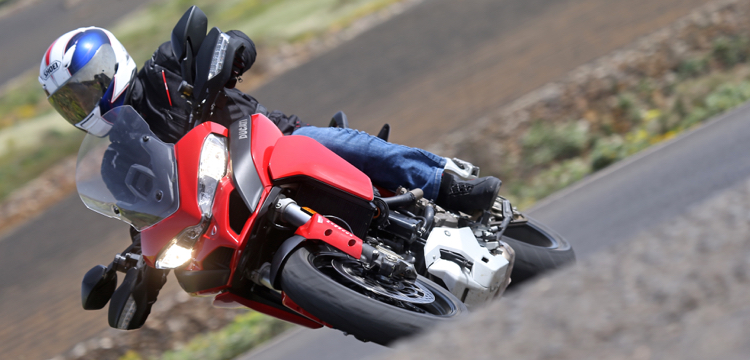
Ducati discovers true refinement without losing its mojo
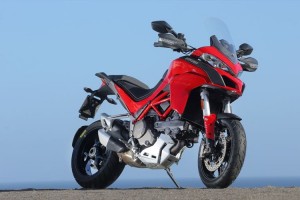
Ducati’s Multistrada made its mark in 2010. Released in 2003, previous models were a hard-nosed, uncompromising, love child of a motard and a sports-tourer. They competed with everything from a big BMW GS to a Honda VFR, but weren’t purposeful enough to be proper competition for either.
The 2010 Multistrada changed that. It lifted the standard of handling, engine performance, ergonomics and functionality considerably — something that the Multistrada desperately needed to compete with motorcycles that all had superbike-like engine performance, sportsbike-like handling and any semblance of comfort. For 2015, the Multistrada 1200 has been refined in every one of those aspects.
Most of that evolution has come with the adoption of the Desmodromic Variable Timing system in the 1198cc engine, but just as much care and detail has been taken to address other areas for improvement across the machine like better comfort when standing on the footpegs, lower and adjustable seat height, more ground clearance and better protection from the elements.
The most striking change, of course, is the new valve system. The Testastretta, which starting life as a racebike motor but has been relegated to road bike use since the release of the Superquadro engine, had an 11-degree valve overlap when it was fitted to the Multistrada in 2010. Valve overlap is the period of crank rotation when both intake and exhaust valves are open simultaneously. Less overlap is good at low rpm; more is good at high rpm (see sidebar). Ducati’s eight-valvers are renowned for high rpm performance but their characteristics at low rpm are not especially favourable on a sport-tourer. The 11-degree overlap in the Multi was a fair compromise but still left something to be desired when revs dropped.
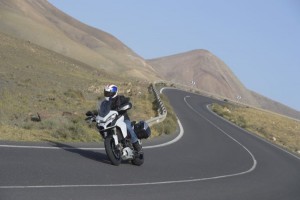
With the time-bending possibilities of the new DVT system, valve overlap can be shifted from -37 degrees to 53 degrees of overlap in less than half a second. In practice, you’ll never feel an abrupt transition as the system goes through its motions, just smooth, relaxed progress through the rev range at any road speed and any speed of application by your throttle hand.
At low revs the lumpiness is gone from the big twin and you can happily roll along at low revs in a gear too high. Getting away from the lights smoothly and easily doesn’t require a lot of thought. It’s like that velvety power delivery that you know a four-cylinder gives you, though it can give you a lot more punch when you need it. Two-up, loaded with gear, these characteristics will make the Multistrada an easy bike to ride up a tight, twisty mountain pass. There’s power just how you want it when you twist the throttle. Ducatisti out there will be upset that that initial bite is gone out the engine response at low rpm, but a lot more riders will enjoy the character it gives the Multistrada, especially as a sport-tourer.
Ducatisti can rest assured that emblematic four-valve sound is there, though notably muted at no compromise to performance. It’s not just quieter exhausts and bigger airboxes these days. It’s all about emissions laws, particularly Euro 4, and the considerable efforts taken to keep the exhaust and noise emissions down.
“We needed to have new cam belt covers that dampen the noise,” says Ducati’s head of engine development, Marco Sauri. “The belts were noisy and we wanted to reduce the guitar effect. The plate on the cover looks aesthetic but it covers the screw that holds the cover to the engine to dampen the noise.” Little things count.
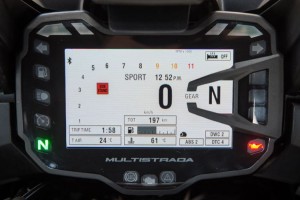
There are two versions of the Multistrada 1200 — the 1200 and 1200S. The differences are purely peripherals with the S-model carrying the bling: semi-active Sachs Ducati Skyhook Suspension (DSS) system, LED cornering headlight, Thin Film Transistor (TFT) instrument display, M50 Brembo Monoblocs, Ducati Multimedia System (DMS) and forged aluminium wheels.
That’s a lot of value on the edges for $4000 extra over the base model. If you’ve got the cash it’s most definitely the way to go, but if you don’t you probably won’t even notice the difference that the manually adjusted suspension, excellent headlight, comprehensive digital dash, radial-mounted Brembos and cast aluminium wheels make. Until you ride the S that is.
The chassis value of the S-model comes through in the handling. Lighter wheels, sharper brakes and the ease of use and excellent control of the semi-active suspension make it better in these aspects. In any other world the base-model would be first pick, but the S model outclasses it here. More is more in any language.
A sports-tourer demands adjustability, and on the 1200S a transition in suspension adjustment is possible at the tap of a button. In the base settings you get a feel for the scope of change possible. From a firm and responsive ride — like a sportsbike — you get Sport mode. Touring is tuned for comfort, not speed, Urban is good on the bumps and hard stops while Enduro is great off-road, but no enduro bike.
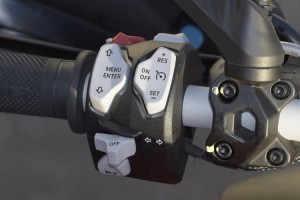
There’s another layer to all of this though. When you press that mode selector button and choose one of those four modes you also get a change in the relationship of the ride-by-wire throttle with the twist grip, level of Ducati Wheelie Control (DWC), Ducati Traction Control (DTC) and ABS. It’s not a token change either. Each mode brings a different relationship between twistgrip and throttle body for a different power delivery character aptly suited to the bike’s name, with 160hp in Sport/Touring and 100hp in Urban/Enduro. What’s more, you can also change those settings — to be more or less — yourself. That’s too much change for me to handle.
Ducati has excelled with the electronics on this bike. Leaving the Skyhook suspension out of this and concentrating on the base-model, the scope of adjustment is emphasised by how varied the brief of a sports-tourer is. If this bike had one job to do, you wouldn’t know it did it so well. But it does the four jobs it claims to perfectly — though I’d argue about a definition of Enduro — through its use of electronics. It’s a proper ride-by-wire system too with no cables at all and some lag dialled in to feel like a ‘proper’ throttle when you twist it.
And while the 1200 doesn’t have the running gear to brag about that the 1200S does, it should only be a state of finances that would sway you either way. Characteristically it is the same handling machine, but it’s the ease of use that Skyhook gives you that may help sway the financial decision.
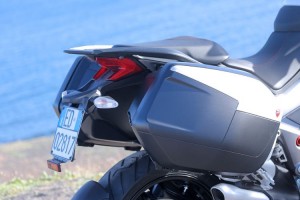
The ergonomic improvements create a lower, longer and wider seat that is easier for shorter riders to reach the ground and more comfortable for everybody — tall or short, rider or pillion.
There’s small touches too like the subtly different clutch cover design that doesn’t get in the way when you are standing. The seat can be adjusted up or down, as can the fairing screen. While the handguards might not be anything against a <i>Quebracho<i> they keep the cold air off your hands without even having to strike a bar warmer.
The sleek subframe design is four kilos lighter and also holds panniers without a kit of any like. If you have the box, you have the mount for it. There’s accessory power sockets, centrestand and cruise control. They are top of my touring checklist. The cornering headlight on the 1200S — while we didn’t get to test it on the launch — is a great thing in theory and when I’ve ridden with one before.
There’s no doubting the capability of the Multistrada as a true all-road machine. It does it all: the off-road stuff might be a bit slower and less aggressive thanks to a 17-inch front wheel and small ground clearance, but you’d need a single-cylinder 650 to do that and what the Multi does.
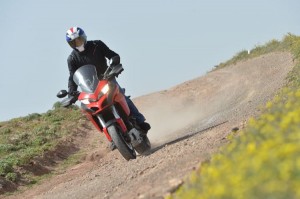
Without the adjustability the electronic controls deliver to the Multistrada 1200, it is a great machine in its own right. Add the controls the 1200 has and you have a sports-tourer at the top of its game. The 1200S with its extras? Well, it’s the jewel in the crown.
TAILOR MADE: The Multistrada’s option packs
Ducati has four accessory pack options for the Multistrada to tailor it to four different styles of rider.
The Touring Pack contains heated grips, panniers and centrestand.
The Sport Pack has a Termignoni muffler, carbon-fibre front mudguard and machined-from-billet aluminium brake and clutch reservoir caps.
The Enduro Pack has fog lights and Ducati Performance components by Touratech; engine protection bars, radiator guard, oil sump guard, bigger side-stand base and off-road footrest.
These three packs each retail for $1787.
Finally, the Urban Pack has a rear top case and tank bag with lock and USB power hub for charging, all for $1098.
MAKING IT WORK: How a fairing panel become the most costly part of a new bike
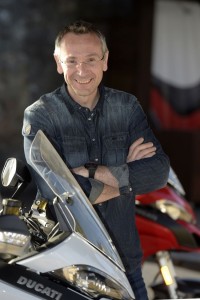
You can’t envy the job of a motorcycle designer. Not often working alone, these teams of talented problem solvers are the bridge between inspired thoughts, evolving technology, consumer demands, stringent cost limitations and quite often brand nostalgia. Every one if these factors can ultimately define a model’s success or failure, and not one of them can be ignored.
Gianfelice Marasco has been a senior designer at the Ducati Design Centre since 2012. This is his first project at Ducati, having worked on Honda’s highly functional CB600F Hornet previously.
“The most challenging part of this design was to try to reflect in the design the new engine characteristics. We have a more fluid, clean engine so we wanted clean and fluid lines. On the other hand we don’t want to ignore the previous model so we kept some characteristics like the nose and the beak.
“There was a lot of effort in the ergonomics — the bike is much slimmer so you can easily touch the ground. The tailpiece is slimmer because when you apply the panniers we wanted the mounting points to be integrated. We have the same volume in these new panniers but they are much narrower.
“The engine is 20mm higher and the seat is 20mm lower. The cylinder heads are bigger too with the DVT. We were looking for millimetres everywhere: reducing engine cover sizes on the engine; making the tank wider and closing all the tolerances around it while keeping the same fuel capacity of 20 litres.”
For the world launch the machines were preproduction and there was still some fine-tuning to be done with the panel fit and finish.
“Between preproduction and production the only things we can change are better fit and finish — the injection moulded plastic can be fine tuned, but that’s it. No big changes now.”
In fact the injection moulded plastic fairing panel was the cause for much discussion in the design process.
“The fairing panel was the most challenging part of the bike, and actually the most expensive part of the bike.
“Due to the shape, the mould for this panel isn’t simple and requires a lot more processes to get its final form. Usually, it’s just a very simple process but due to the shape — and there’s one screw to hold it in for a clean look — it was very expensive.
“There were big arguments with the project engineer who is responsible for the budget. We wanted to keep the style!”
ENGINE EVOLUTION: It’s now perfectly refined. So what’s next?

The Multistrada’s Desmodromic eight-valve engine is the first in a Ducati to feature variable valve timing, the Desmodromic Valve Timing (DVT) system.
The previous generation of Testastretta engines had a valve overlap of 11 degrees. Overlap is the period in degrees of crankshaft rotation with which both inlet and exhaust valves are open on the on the exhaust stroke of the piston. The shorter the overlap, the better running the engine is at low rpm, but a bigger overlap means more efficient combustion at high rpm and, as a result, more power.
“We wanted to retain the powerful character of the Multi, but we knew the longitudal surging at low rpm wasn’t good like it was on our competitors’ machines in this category,” says Marco Sairu, head of Ducati’s engine project management.
“We wanted both those characteristics: smoothness and the power. Four valves helps in volumetric efficiency and increasing revs quickly, so to get this character DVT was the way to make it happen.”
The range of valve overlap now varies from -37 to 53 degrees through 90 degrees of crank rotation to provide cleaner combustion at low rpm and to get more fuel into the cylinder head at high rpm. The cam phasing at high speed can move through its full range in 0.45 seconds.
The DVT system was first mooted three and a half years ago. After flaunting with the three-valve engine family to create better low-rpm manners while retaining high-rpm performance, staying with the four-valve engine design was undoubtedly the way forward.
“The target was clear, the challenge was achieving it,” says Sauri. “Some people thought it was the Audi Group influence that saw this come to fruition, but plans started earlier.
“As soon as we arrived in the group, they were really open and exchanging experiences. They said, ‘Guys, we have huge experience in every field of engine technology so if there’s anything you need to know just ask’.
“We were at the point where we were doing bench tests and given that opportunity we asked them, ‘What are the most critical points for this kind of system?’ This helped shorten the development time, but the design was all ours.”
So where to next for this new technology for Ducati?
“The scope for valve overlap range is ideal, so we won’t see that change. The next development in the system comes from better mapping.
“The next step in engine evolution in general though, the big developments will come from metallurgy. Materials and coatings that will allow the systems to work better and be more efficient — in terms of thermodynamics and friction. The electronics are innovating very quickly, so in performance and safety it will come along quickly too.
“Where we see the biggest benefits from is with simulations. Being able to use software that is more and more advanced and give you the preview on what you can expect in a certain configuration, and another one. We can then change some parameters, check this, check that and change the sensitivity to certain parameters to arrive at the test bench with a lot of filtering done at this point. That would really see things evolve more quickly.”
Model: 2015 Ducati Multistrada 1200 DVT
Price: $23,990 (1200S: $27,990 in red, $28,490 in white) + on-road costs
Colours: Ducati Red (1200S: Ducati Red and Iceberg White)
Warranty: 24 months, unlimited kilometres
Servicing intervals: 12,000km
Engine: Liquid-cooled four-valve per cylinder DOHC V-twin with Desmodromic Variable Timing (DVT). Variable engine mapping and power
Bore x stroke: 106 x 67.9mm
Displacement: 1198cc
Compression: 12.5:1
Power: 118kW @ 9500rpm
Torque: 136Nm @ 7500rpm
Transmission: Wet multiplate clutch, six-speed gearbox, chain drive
Frame: Tubular steel trellis
Dimensions: Seat height 825-845mm, dry weight 209kg (1200S: 212kg), fuel capacity 20L, wheelbase 1529mm, rake 24º, trail 109mm
Suspension: Front, 48mm Sachs USD forks, fully adjustable, 170mm travel. Rear, monoshock, fully adjustable, 170mm travel. 1200S: semi-active, electronically adjusted Ducati Skyhook Suspension
Website: www.ducati.com.au
PHOTOS: MILAGRO

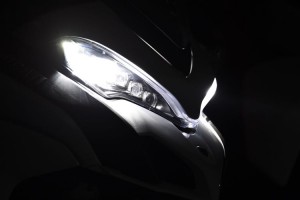
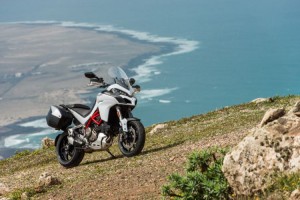


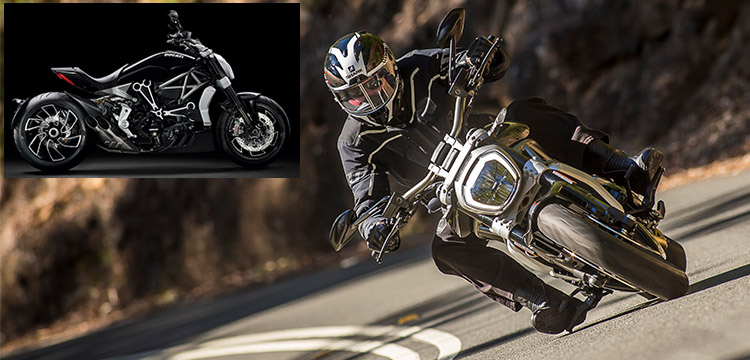
Like!! I blog frequently and I really thank you for your content. The article has truly peaked my interest.
Status Liker, Autoliker, Autoliker, ZFN Liker, Photo Auto Liker, auto like, Auto Like, Increase Likes, Status Auto Liker, Working Auto Liker, autolike, Auto Liker, Photo Liker, auto liker, Autolike, autoliker, Autolike International
Cuanto Cuesta El Viagra Priligy Stories Buy Prednisone Acetate Eye Drops Buy Cialis Cialis Generika Per Paypal
Express Pharmacy New Zealand Propecia Sale Drugstore Cialis Commander Cialis Generique Nitrostat With Out Rx
Prix Viagra 25 Milligrams Propecia 2 5 Cialis Online Pharmacy Next Day Delivery Macrobid 100mg Shop
Finasteride 1 Mb Propecia Cialis Viagra Naturale Femminile
Viagra With No Prescription Ingredients Cephalexin Cialis Worldwide Real Acticin 30gm From Canada Viagra Kaufen Mallorca
Propecia Makes Hair Loss Worse Drug Interaction Coumadin Amoxicillin Cheap Viagra Without A Prescription viagra vs cialis Buy Dapoxetine Hcl Online Tetracycline And Amoxicillin Levitra Rendeles
Propecia Vendita Where To Buy Effexor Over The Counter Cialis No Prior Prescription Buy Cialis Can Amoxicillin Be Used For Acne Par 701 Clomid For Sale
buy furosemide 40 mg online uk
doxycycline 50 mg
celebrex 100
where can i buy clomid over the counter
fluoxetine 40 mg daily
how to get clomid
buy valtrex online
diflucan 200mg
fluoxetine 10mg tablet
avodart generic
prices zoloft mexico
tadalafil 20mg
20 mg prednisone tablet
doxycycline price uk